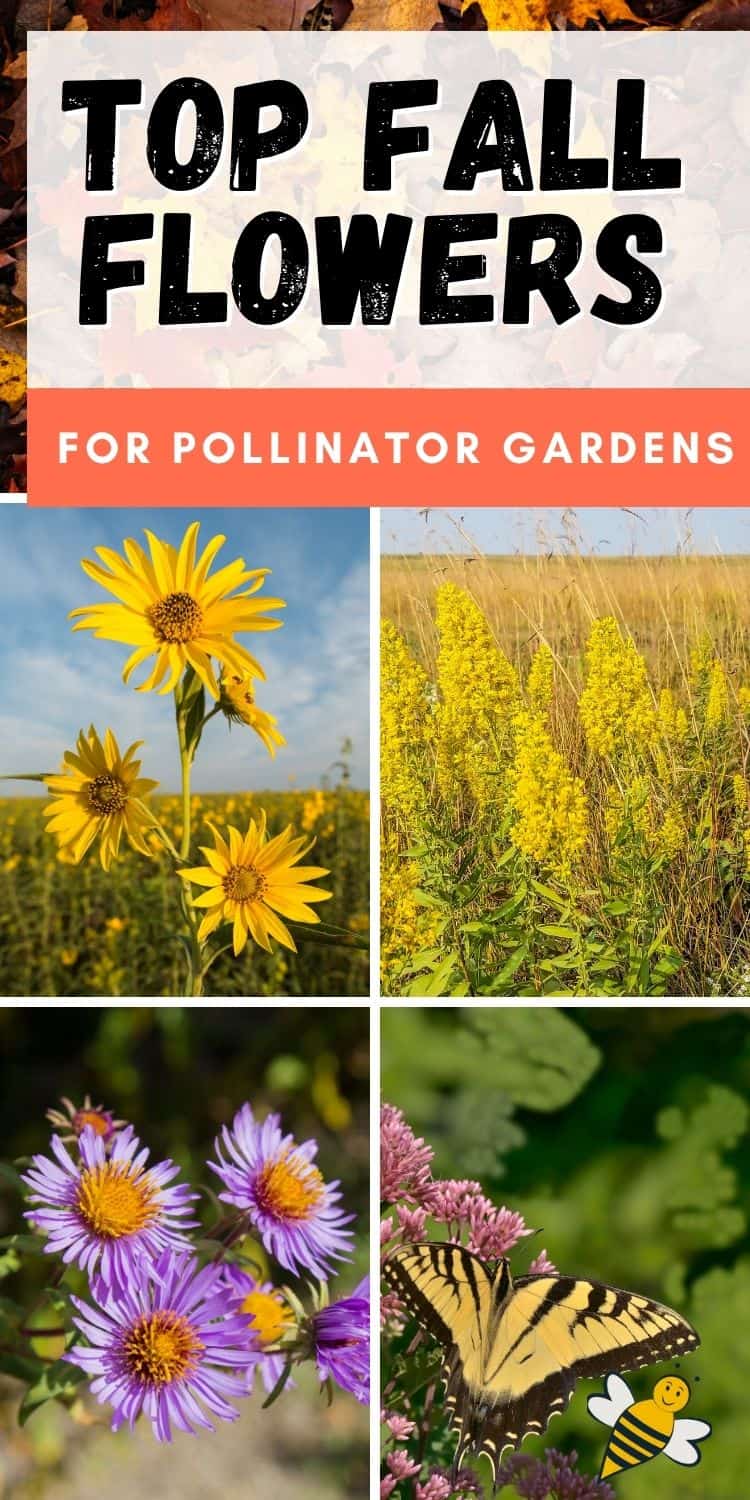Best Fall Flowers for Bees
As the colorful blooms of Summer begin to fade, your bee garden enter an important phase. Fall flowering plants help honey bees, bumble bees and migrating butterflies that are depending on that last bit of nectar and pollen before Winter. This guide of the top Fall flowers for bees gives tips to help you enhance and extend the season for area pollinators.

I try to include a variety of flowers in my bee friendly garden and yard landscape. Each one provides different nutrition in the nectar and pollen and a long bloom season is always the goal.
Why Fall Flowers are So Important for Bees
After a hot Summer, I dream of the cooler days to come. But in my beehives, a struggle for survival is taking place. For honey bee colonies, late Summer into Fall is a critical time to store food.
And, it is not only honey bees. Those insects that don’t overwinter as a family-but hibernate (such as the Queen Bumble Bee), will be out looking for a last bit of nutrition.
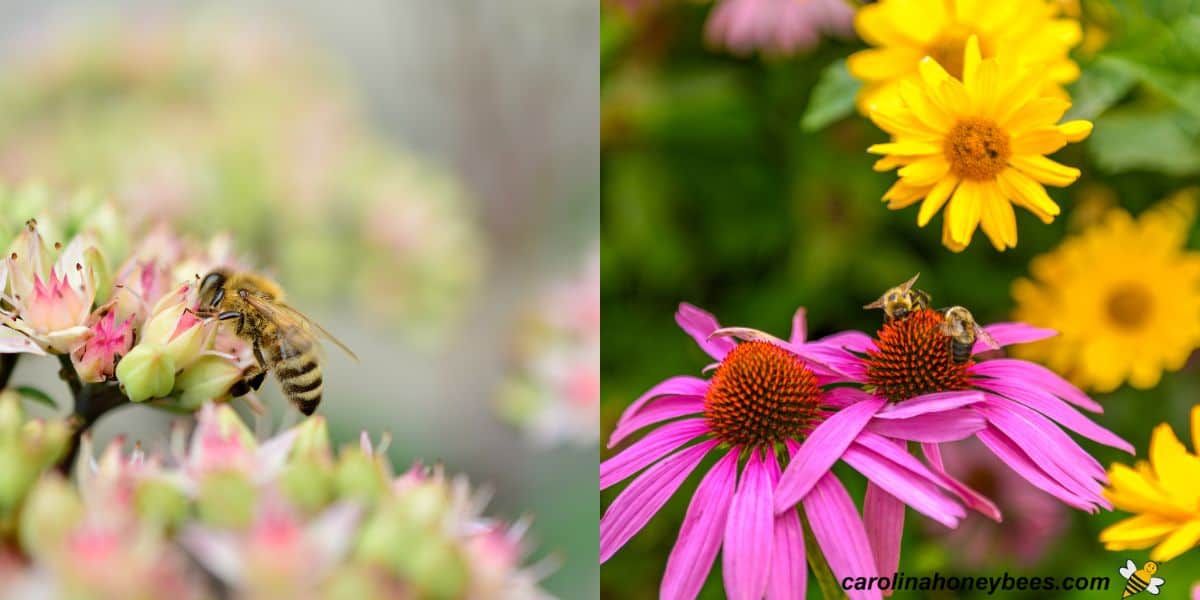
What things should you look for when choosing good Fall flowers for the bees? Well of course, you must also consider climate and growing conditions but there are more considerations.
Beneficial Characteristics:
- produces nectar, pollen or both
- bright attractive colors
- long bloom period
Bees see flowers differently than we do with our human eyes. But, they seem particularly attracted to shades of blue, purple and yellow.
These autumn pollinator plants are known for being easy to grow in a variety of climates and producing nectar or pollen even in imperfect conditions.
Essential Fall Plants for Pollinators
Let us begin with the most popular or well-known autumn flowers that we see bees enjoying.
- Goldenrod
- Black-eyed Susan
- Asters
- Bee Balm
- Joe Pye Weed
- Sedums
- Japanese Anemones
- New England Asters
1. Goldenrod (Solidago spp.)
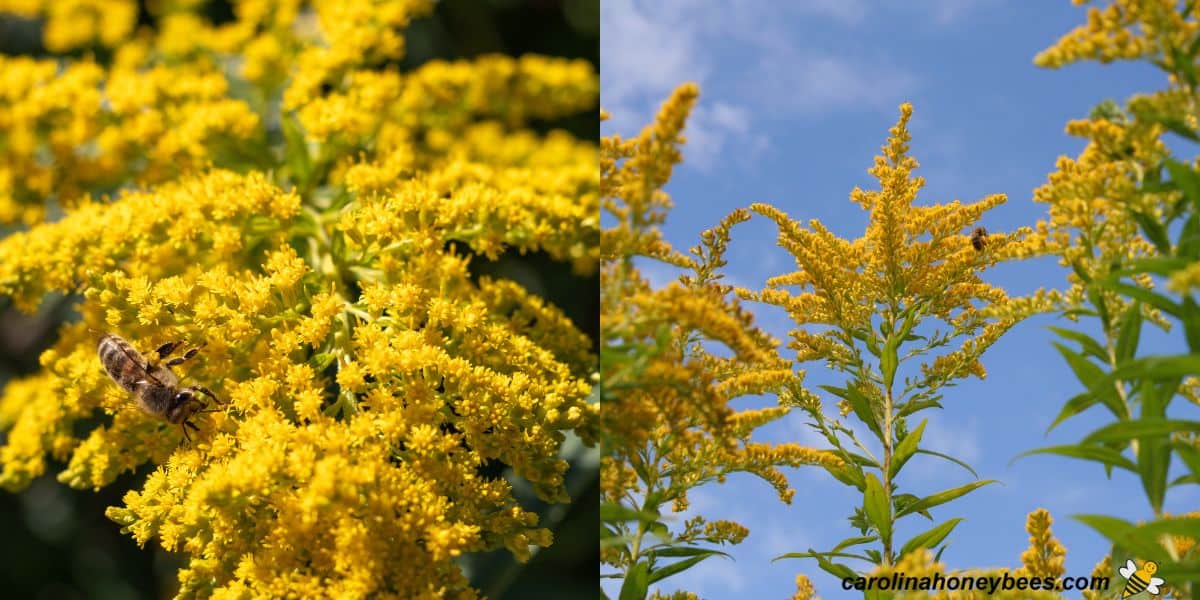
This plant is one of the most important fall blooming flowers for pollinators. Providing large amounts of both nectar and pollen, this native plant does it all.
Yes golden rod flowers are valuable to bees. In fact, in some regions of the country, the nectar is so abundant that the bees make produce a honey crop.
While Goldenrod honey has a reputation of smelling like dirty gym socks while the bees are gathering nectar – it is a good honey that some folks enjoy and bees can certainly use it.
North America boasts over 100 different species of goldenrod and you can find commercial cultivars too.
Choose a tall species if you want to create a mass planting as a backdrop in your pollinator garden. The shorter types of goldenrod can be used anywhere in the garden.
Full sun is great but this plant is not picky about soil. Mine grows well in partial shade. Showy yellow flowers in late season will attract many bees to the area.
Goldenrod is often blamed for late season allergies. This is not true in most cases. Ragweed is the allergy culprit instead.
2. Black-eyed Susan (Rudbeckia Goldstrum)

Black-eyed Susan is an easy to recognize perennial plant that begins to bloom in mid Summer. Mine bloom even in dry conditions. New blooms continue into the Fall-lasting weeks at a time.
Their bright yellow daisy like flowers brighten up any area and mine actually bloom well in partial shade. This plant is not aggressive but it will spread by seed. I keep mine contained to one area of the garden.
Bees enjoy visiting the blooms for nectar and the seeds produced help feed birds. However, if you let them go to seed – you may end up with more plants that you want.
3. Asters (Symphyotrichum spp.)
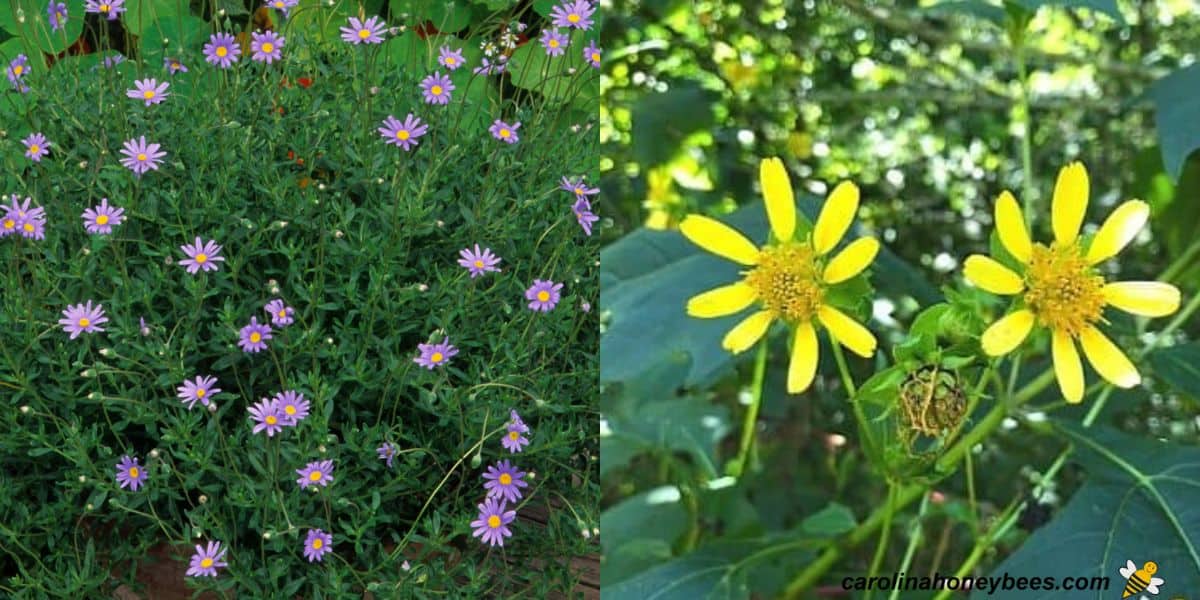
Asters are a popular choice for fall gardens and many of them are attractive to bees. With daisy like flower shapes in a wide range of colors, they make a beautiful display.
There are many types of asters and some are suitable for every region of the United States. Species are available that do well from wetland restoration to dry forest edges.
Hairy Leafcup (Smallanthus uvedalius) (pictured above on the right) is a native bee friendly wildflower that looks like a weed!
I found this growing in my backyard and it returns every year. A tall yellow member of the aster family it is attractive to bees and other pollinators.
Many asters are small stature plants that often go unnoticed. Others can reach heights over 6 feet. All play an important role in feeding pollinators.
4. Bee Balm (Monarda spp.)

A constant favorite in the bee garden, bee balm feeds pollinators all season long. Thankfully, the vibrant red, pink or purple flowers continue to bloom well into Fall.
A long bloom period and abundant nectar producers – you will find honey bees. bumble bees and other pollinators visiting.
In fact, the deep flower shapes are especially attractive to humming birds and bumble bees with a longer tongue than honey bees.
5. Joe Pye Weed – (Eupatorium purpureum)

Joe Pye weed grows wild along the banks of the streams. If you do not have any locally, you can buy seeds and grow your own.
The tall plants are great to use as a background feature. They can be planted in Spring or Fall and like moist soil and partial shade.
Before becoming a beekeeper, I thought of this plant a just a tall weed. But, it is a welcomed plant in any herbal garden landscape.
Joe Pye Weed was reportedly named after a New England herb doctor. He used the plant to create medicines to treat common ailments.
In late Summer and into Fall, bees, butterflies and other pollinators are attracted to the sweet nectar.
6. Sedums (Sedum spp.)
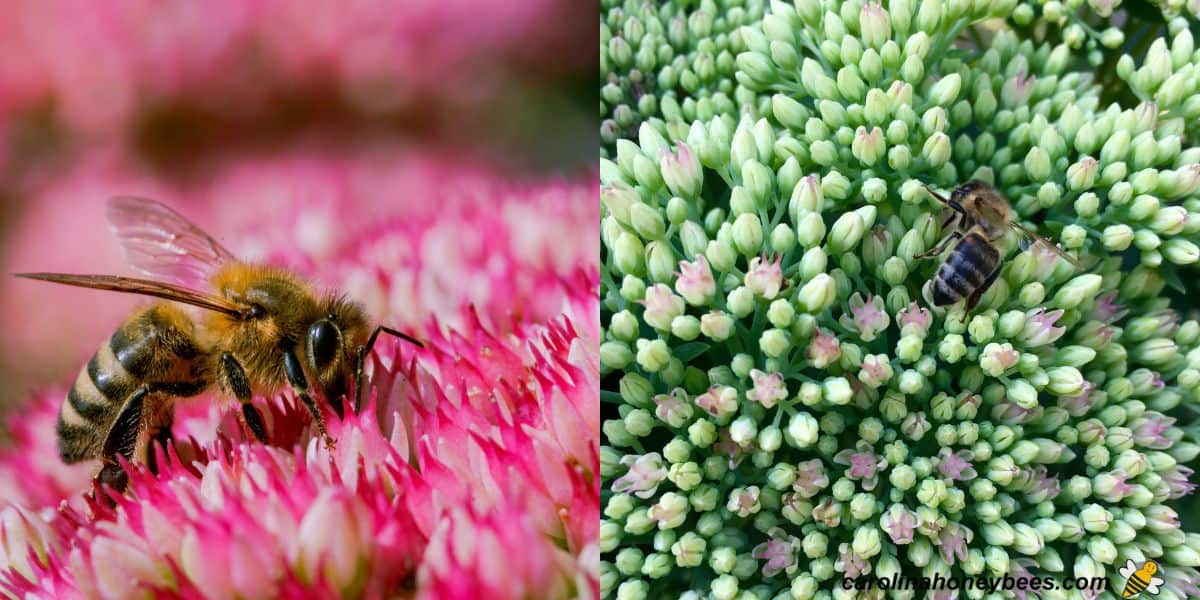
Sedum plants are a staple of any garden in zones 3 to 8. These long-lived perennials have thick succulent leaves and can thrive with minimal watering.
One of my favorites and easiest to grow is Sedum Autumn Joy – Stonecrop (Hylotelephium telephium). You do not have to be a Master Gardener to have success with sedums. They thrive on neglect.
In late Summer and into Fall, pink flowers appear. Honey bees, bumble bees and other insects collect nectar from the flower clusters.
Sedums bloom for a long time and continue to provide nectar until frost in most locations.
7. Japanese Anemone (Anemone hupehensis)

Also called, Windflowers, Japanese anemones are a delightful addition to the Fall pollinator garden. A herbaceous perennial it is a member of the buttercup family (Ranunculaceae).
Native to parts of China they can grow up to 2 1/2 feet tall. Their simple flower shape is very attractive to bees during the September to November bloom time.
I have found them a bit delicate in my red clay soil but some gardeners report great success.
8. New England Asters (Symphyotrichum novae-angliae)
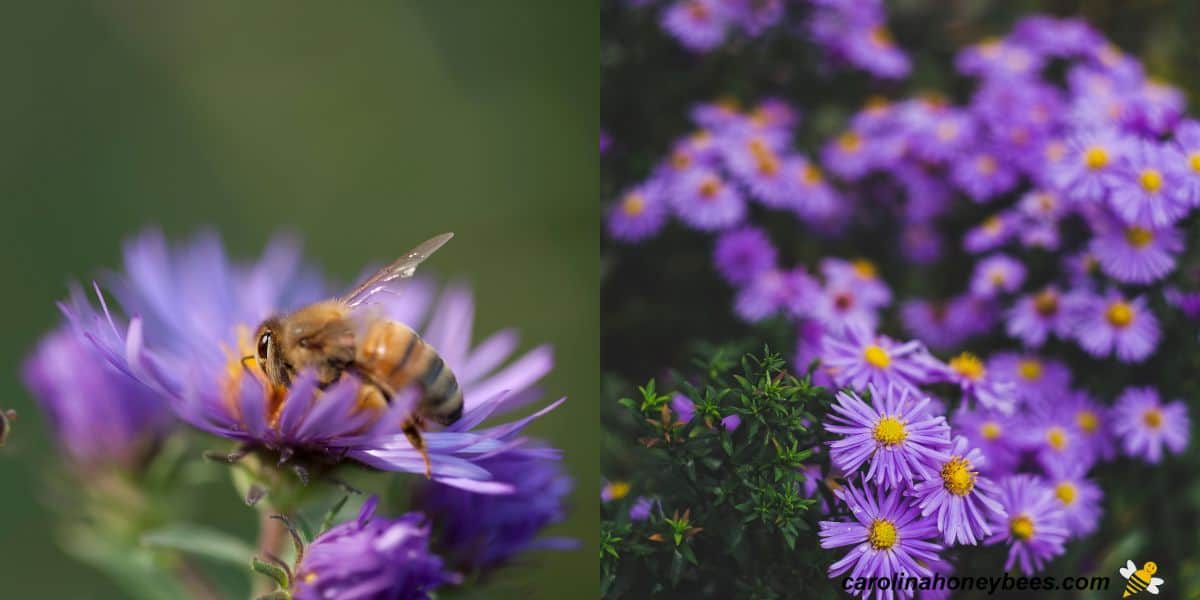
A native wildflower, New England asters are also grown for landscaping use. They burst into colorful deep purple flowers with golden centers during Fall.
A wide range of bee species are attracted to the blooms looking for important food resources before Winter. New England aster grow in a clumping form but they can be divided after several years.
Other Beneficial Autumn Plants for Bees
The blooming plants are especially important during those last few weeks before cold arrives. You can add to the bloom by purchasing plants, bulbs or even starting plants from seed.
Best of all – many are perennial flowers that bees love and will bloom year after year. Also, some of the flowers of Summer that we love will continue to bloom until frost!
- some varieties of sunflowers for bees – i.e. Maximilian sunflower
- zinnias (Zinnia spp.) – one of my favorites
- borage (Borago officinalis) – I grow borage from seed
- Lavender (Lavandula spp.)
- anise hyssop (Agastache foeniculum)
Another unusual plant that feeds bees and blooms into Fall is the luffa plant. Gardeners love to grow luffa to make “sponges” from the fruit.
But, growing luffa flowers for bees is fun too. Just be sure to get an early start – they need a long growing season.
FAQs
Yes, many Fall flowers that bees like grow well in containers. Brighten up your patio or deck with some colorful Autumn blooms and you may have a few winged visitors.
Any nectar rich plant that will bloom before cold arrives will benefit the bees. However, get them out there while there are still some warm afternoons for the bees to forage.
Most Fall blooming flowers are beneficial to bees or at least not harmful. Avoid plants treated with pesticides as they may harm all pollinators.
A Final Word
Some people say that planting for bees is not worthwhile unless you have large fields. I don’t agree. I believe that even a small resource can help. It is important to remember that not every flower provides nectar. Check with local gardening agencies in your area to learn exactly which plants do best in your climate. And, plant a few extra Fall flowers for the bees to enjoy before the Winter cold arrives.

